21 Simple Organic Modern Kitchen Ideas for Natural Functionality
Imagine stepping into a kitchen that feels both effortlessly stylish and deeply connected to nature—that’s the charm of a simple organic modern kitchen. These designs are gaining popularity for their clean, calming aesthetics that bring warmth and functionality into everyday cooking and gathering spaces.
In this article, you’ll explore a variety of ideas that blend natural materials, minimalistic layouts, and thoughtful details to create a space that’s both practical and beautifully serene. Whether you’re looking to refresh your current kitchen or start from scratch, these ideas will inspire you to embrace the beauty of organic simplicity and modern elegance.
1. Embrace Warm Wood Cabinets for a Cozy, Natural Look
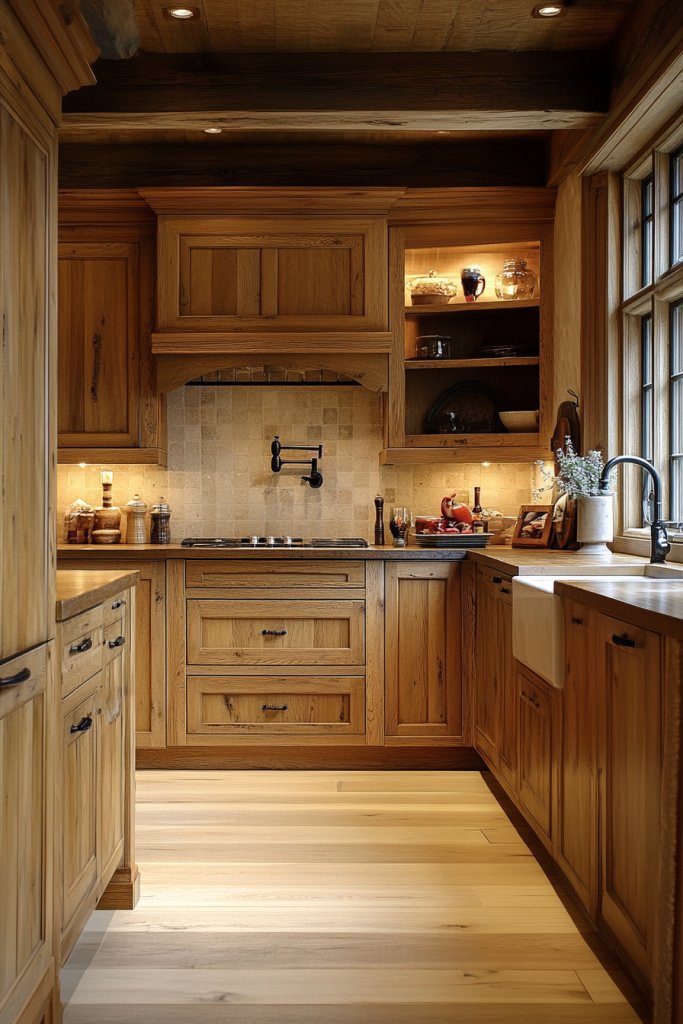
Ever feel like your kitchen is missing that warm, inviting vibe? Cold, glossy cabinets can sometimes make a space feel sterile rather than cozy. Many homeowners crave a natural look that makes cooking and gathering feel more relaxed. The solution? Warm wood cabinets that instantly add character and comfort.
Picture soft, light-toned reclaimed wood cabinets with visible grain patterns that catch the light just right. Think of a kitchen with open shelving displaying earthy ceramics and textured linens nearby. The wood’s natural imperfections add authenticity, while subtle knots and streaks evoke a sense of nature’s artistry. The tactile surface invites touch, making the space feel grounded.
Choose lighter woods like pine or oak for a bright, airy feel, or go for darker, richer tones like walnut for a more dramatic look. For small kitchens, sleek flat-panel designs keep the space feeling uncluttered. In rustic or farmhouse styles, distressed finishes and chunky hardware enhance the cozy vibe. Seasonal accents like warm-colored textiles or cozy throws can transform the look throughout the year.
Start by selecting sustainably sourced or reclaimed wood for an eco-friendly approach. Decide on a finish—paint, stain, or natural oil—that enhances the grain. Installing simple shaker-style cabinets offers a classic look, while flat panels keep it modern. Use soft-close hinges and minimalist hardware to maintain a clean aesthetic. Regular sealing and oiling preserve the wood’s natural beauty over time.
Personalize with custom woodgrain patterns or subtle color washes that match your decor. Add a touch of uniqueness with hand-carved details or vintage-inspired hardware. Incorporate open shelving with wooden brackets to display your favorite dishes or decorative items. Finish with a soft, matte varnish to keep the natural texture visible and inviting.
Warm wood cabinets instantly elevate your kitchen’s charm and make it feel like home. They blend seamlessly with natural materials and can adapt to various styles, from modern minimalism to rustic farmhouse. With the right finish and hardware, you’ll create a space that’s both functional and soulful. Your kitchen will become the heart of your home, welcoming everyone with open arms.
2. Incorporate Open Shelving with Earth-Toned Dishware
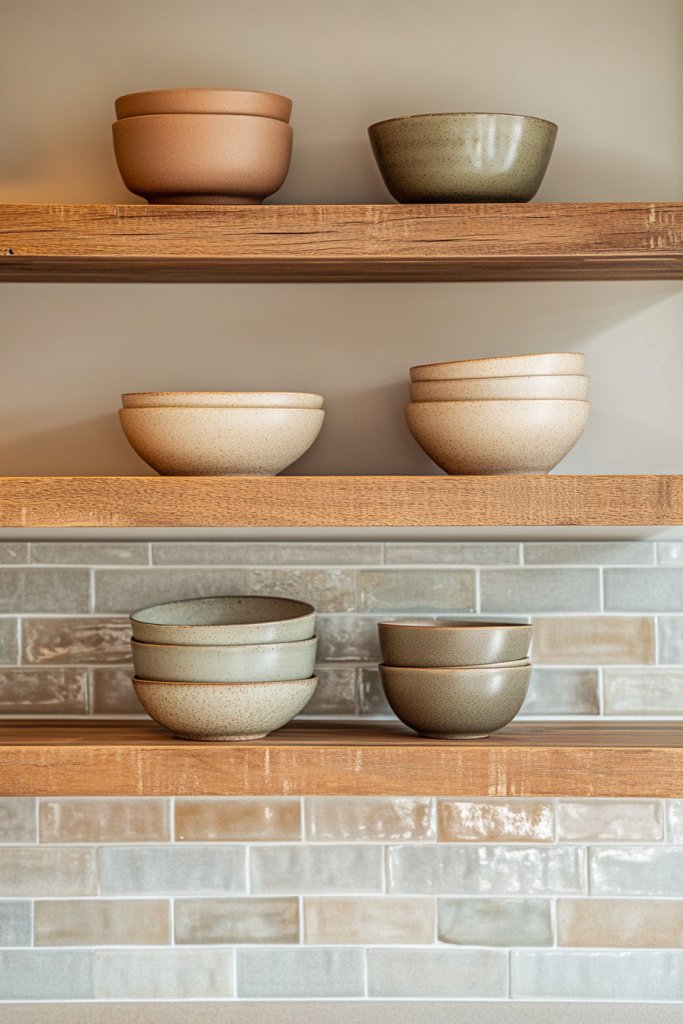
Ever feel like your kitchen is cluttered and chaotic? Storing everything behind closed doors can sometimes hide your personality and make the space feel dull. Open shelving offers a simple fix that adds character while keeping essentials within reach. Plus, displaying earthy dishware brings a natural, calming vibe.
Imagine a set of matte ceramic bowls in warm terracotta hues, stacked neatly on rustic open shelves. Woven baskets hold neatly rolled napkins and utensils, while clear glass jars showcase grains and legumes. The combination of textured ceramics and natural fibers creates an inviting, lived-in look. Sunlight streams in, highlighting the warm tones and making the space feel fresh.
For a minimalist look, choose sleek, monochrome dishware in earthy shades like olive green or soft beige. In boho-inspired kitchens, mix and match patterned ceramics with textured wood accents. Small kitchens can use open shelves for critical items, while larger spaces can feature full wall installations. Seasonal swaps, like adding colorful mugs or textured platters, keep the display lively.
Install floating wooden or metal brackets designed to support weight comfortably. Arrange dishes by size and color for visual harmony. Use natural, matte-finished ceramics to maintain organic appeal. Keep everyday items accessible, but reserve decorative pieces for special occasions. Mix in natural materials like rattan or cork coasters for added texture. Regularly clean and organize to prevent clutter from building up.
Create a curated collection of dishware that reflects your style—think handmade pottery or vintage finds. Incorporate open shelving with decorative edge trims or painted backs in muted tones. Use labels on jars or baskets for a tidy, organized look. Add personal touches like a set of handcrafted mugs or a unique serving platter to make the display truly yours.
Open shelving with earth-toned dishware adds warmth and personality to your kitchen. It’s an easy way to showcase your taste while keeping essentials handy. With a little effort, you turn everyday items into artful decor. Embrace the natural textures and colors to create a space that feels both functional and inviting.
3. Install Understated Matte-Finish Stone Countertops
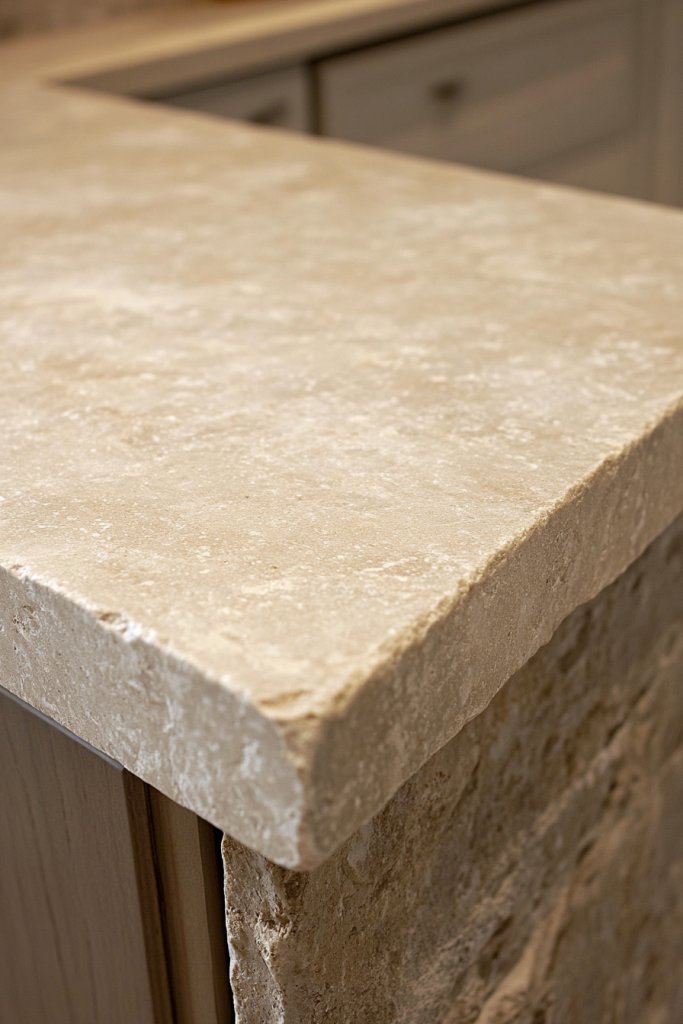
Tired of countertops that look shiny and artificial? Flat, glossy surfaces can sometimes clash with organic decor. What you really want is a durable, tactile surface that blends seamlessly with a natural aesthetic. Matte-finish stone countertops are the answer, offering both function and understated style.
Imagine a honed granite countertop in muted gray, with a velvety matte finish that feels soft to the touch. The surface absorbs light instead of reflecting it, creating a calm, subtle backdrop for your kitchen. Natural variations and tiny mineral flecks add depth, making each slab unique. The texture invites you to run your fingers over it, adding a sensory layer to your space.
Choose soapstone for a softer, darker look that develops a unique patina over time, or opt for honed granite in neutral tones for a sleek, modern vibe. For rustic kitchens, rougher textures with visible mineral inclusions enhance authenticity. In contemporary spaces, clean lines with minimal edging keep it sophisticated. Seasonal accents like woven mats or linen towels can soften the look further.
Select high-quality, sustainably sourced stone slabs with a matte finish. Professional installation ensures precise cuts and secure sealing, which is crucial for longevity. Use a gentle, pH-neutral cleaner to maintain the matte surface without scratches. Consider integrated sinks or undermount options for a seamless look. Regular sealing protects against stains and preserves the tactile feel.
Add subtle inlays or carved details to enhance the organic feel. Pair with natural wood or bamboo accessories to complement the stone’s understated elegance. Use handcrafted cutting boards made from olive or maple wood for a cohesive look. Keep the surface clutter-free with sleek, minimalist utensil holders or storage containers in ceramic or natural fiber materials.
Matte-finish stone countertops elevate your kitchen’s natural, understated charm. They complement organic decor beautifully and are built to last. With proper care, they become a timeless feature that adds value and tranquility. Embrace the tactile experience and enjoy a kitchen that feels as good as it looks.
4. Use Simple, Uncluttered White or Neutral Backsplashes

Does your kitchen feel busy or overwhelming? Cluttered backsplashes can add visual noise, detracting from a calming, organic vibe. A simple, neutral backsplash acts as a clean canvas, letting natural textures and materials shine. It’s the perfect way to keep your space fresh without feeling cold.
Picture large-format tiles in soft beige or off-white, with subtle textured surfaces that catch the light gently. The tiles are arranged with thin grout lines, emphasizing minimalism. The backdrop creates a serene environment, highlighting natural wood cabinets and woven textiles. A few artisanal accessories or handcrafted utensils add personality without clutter.
Use large, matte tiles for a seamless look or opt for subtle subway tiles with textured surfaces for added interest. For a rustic touch, choose reclaimed brick or stone in muted tones. Seasonal updates can include colorful, hand-painted tiles or textured mosaics that don’t overwhelm the overall aesthetic. Keep it simple for small spaces and more textured for expansive kitchens.
Select neutral, high-quality tiles with matte or lightly textured finishes. Professional installation ensures straight lines and even spacing, critical for a clean look. Use minimal grout in matching shades to enhance the seamless appearance. Seal the tiles and grout to prevent stains and moisture buildup. Keep the rest of the decor minimal, emphasizing the clean backdrop.
Add a handcrafted tile border or a subtle geometric pattern for a touch of detail. Use natural fiber or linen cloths to soften the look and add tactile warmth. Incorporate open shelving above for displaying essential items. Keep accessories and tools in muted, natural finishes like cork, wood, or ceramic to maintain harmony.
A simple, neutral backsplash grounds your kitchen in calm, organic beauty. It’s versatile and timeless, easily updated with seasonal accents or accessories. Such a setup invites relaxation and focus on natural textures. Transform your kitchen into a peaceful oasis with minimal fuss.
5. Add Natural Fiber Pendant Lighting for Soft Illumination
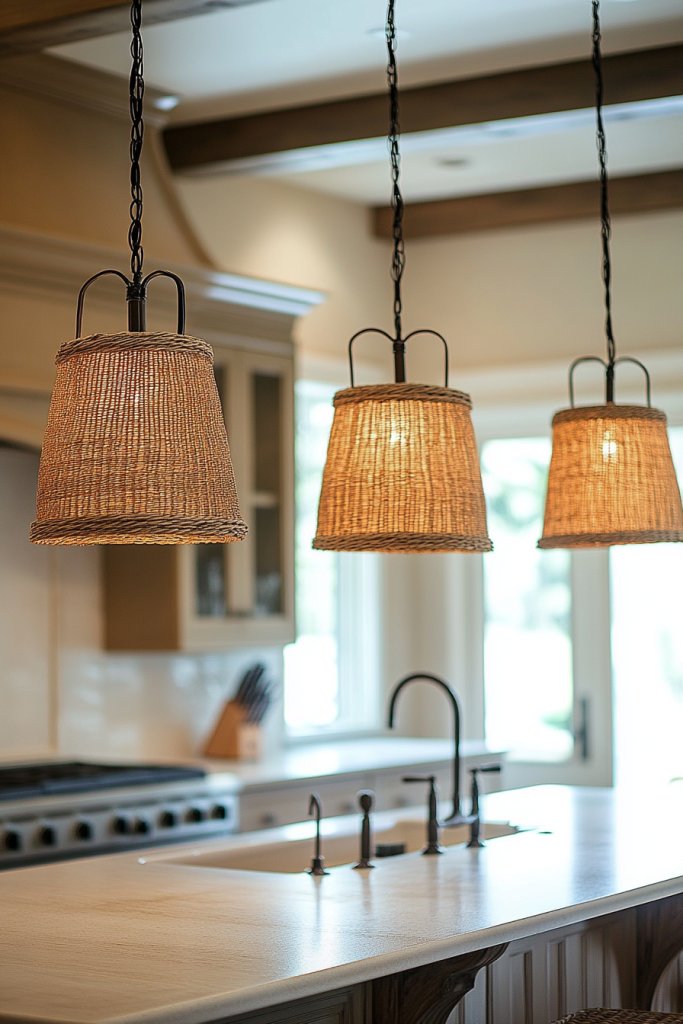
Ever notice how harsh lighting can kill that cozy, organic vibe? Bright, overly modern fixtures can clash with natural materials. You want a light source that adds warmth and softness without sacrificing style. Natural fiber pendant lighting hits the sweet spot, creating a gentle glow that feels inviting.
Imagine woven rattan or bamboo pendant lights hanging over a rustic wooden island. The textured fibers diffuse light softly, casting warm, dappled patterns across the space. The natural materials add texture, creating a layered look that complements clay, linen, and wood. The ambient glow enhances the organic, tranquil atmosphere.
Select pendant lights with woven or braided fibers in neutral tones like beige, taupe, or soft gray. For a more contemporary twist, choose sleek, sculptural designs in natural fibers with clean lines. In larger kitchens, cluster multiple pendants at varying heights for visual interest. Seasonal shifts can include adding fabric or tassels for a playful or cozy touch.
Install pendant fixtures with adjustable cords to control height and light distribution. Use warm LED bulbs to enhance the natural fiber’s warmth. Avoid overly bright or cool tones, which can feel clinical. Pair the pendants with dimmer switches for adjustable ambiance. Ensure the fixtures are securely mounted and easy to clean, as natural fibers can attract dust.
Mix different fiber textures or weave styles for a personalized look. Incorporate tassels, beads, or ceramic accents to add a handcrafted touch. Use fabric or linen shades underneath for extra softness. Hang the pendants at varying heights to create visual rhythm and harmony based on your space.
Natural fiber pendant lighting lends warmth and texture that elevates your kitchen’s organic style. It’s a simple change that makes a big impact on ambiance. With a variety of designs available, you can find fixtures that reflect your personality and enhance your space’s natural charm. Brighten your home with style and soul.
6. Incorporate Live Edge Wooden Breakfast Bars or Islands

Looking for a statement piece that embodies organic beauty? Standard countertops can feel sterile; a live edge wood surface brings nature directly into your kitchen. It combines functionality with a rugged, natural aesthetic that’s impossible to ignore. Plus, it’s a conversation starter for sure.
Imagine a kitchen island topped with a thick slab of reclaimed oak, its uneven edge preserved to showcase the tree’s natural shape. The rich grain and variations in color add depth and character. The surface’s rough edges contrast beautifully with sleek, modern cabinetry and subtle lighting. It feels grounded, earthy, and alive—like a slice of nature itself.
Use different woods such as walnut, maple, or cherry for varied tones and textures. For small spaces, a narrow live edge breakfast bar can serve as a casual dining spot. In rustic or farmhouse kitchens, leave the edges untouched for maximum authenticity. Seasonal accents like woven placemats or fabric runners enhance the organic feel further.
Source slabs from reputable suppliers specializing in reclaimed or sustainably harvested wood. Seal the surface with food-safe oils to enhance durability and natural look. Mount the live edge slab on sturdy, hidden supports or custom-built bases. Regularly oil or treat the wood to prevent drying or cracking over time. Consider integrating storage underneath for maximum practicality.
Add handcrafted or engraved details to the wood for a personal touch. Pair with minimalist metal or ceramic accessories to keep the look balanced. Use natural fiber textiles on seating or table runners to complement the organic aesthetic. Incorporate a subtle finish like a matte varnish to protect while maintaining roughness.
A live edge wood surface instantly elevates your kitchen’s natural charm. It’s a unique blend of art and function, making your space truly one of a kind. With proper care, it ages beautifully and becomes even more characterful over time. Embrace the raw, natural beauty of wood to create a warm, welcoming environment.
7. Choose Minimalist, Eco-Friendly Hardware and Handles
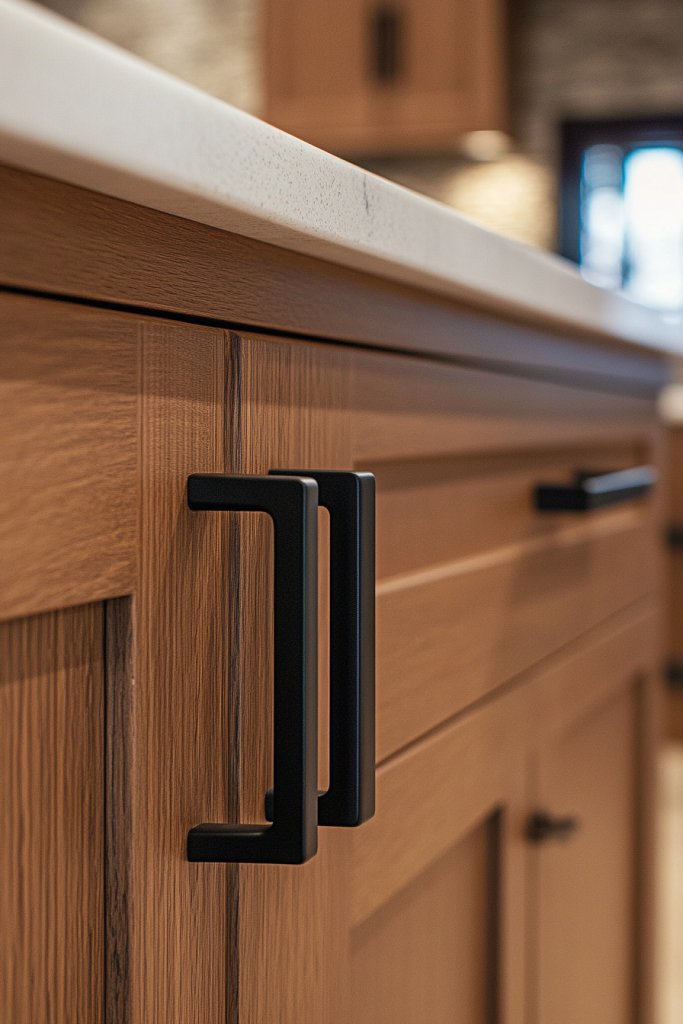
Are bulky, ornate handles distracting from your organic decor? Hardware can often become an eyesore when you aim for a clean, natural look. The solution? Minimalist, eco-conscious handles that blend seamlessly into your cabinets. They add functionality without stealing the show.
Visualize matte black or brushed bronze pulls with sleek, simple lines on light wood cabinetry. Handles are unobtrusive, allowing the natural grain to take center stage. The hardware’s subtlety enhances the overall harmony, while the matte finishes add a soft, organic touch. It’s all about understated elegance that feels effortless.
Opt for unloved wood pulls, brass or copper accents for warmth, or minimalist bar handles for a modern look. For a more rustic vibe, choose raw iron or forged metal handles. Small kitchens benefit from integrated or finger pulls that keep surfaces smooth. Seasonal changes can include swapping handles for different finishes or textures.
Select hardware made from sustainable materials—such as recycled metal or reclaimed wood. Measure cabinet openings carefully for proper sizing and placement. Use a drill and level to ensure even installation. Tighten all screws securely, but avoid overtightening to prevent damage. Regularly clean handles with natural oils or gentle cleaners to maintain their finish.
Create a cohesive look by choosing hardware in matching tones across all cabinets. Add engraved initials or subtle patterns for a handcrafted feel. Incorporate decorative accents like leather or linen pulls for a soft touch. Keep the hardware clean and shiny to preserve its minimalist appeal.
Simple, eco-friendly hardware elevates your kitchen’s natural aesthetic and supports sustainability. It’s a small detail that makes a big difference in overall harmony. With the right choices, your space will feel modern, warm, and thoughtfully curated. Minimalist hardware is the finishing touch that ties everything together beautifully.
8. Incorporate Sustainable, Non-Toxic Paints in Neutral Shades

Tired of chemical-laden paints that compromise your home’s air quality? Many traditional paints emit volatile organic compounds (VOCs) that can cause headaches and long-term health issues. The answer is sustainable, non-toxic paints in soothing neutral shades that promote a healthier environment.
Visualize soft taupe or muted olive walls with a matte finish, creating a calming backdrop. The subtle hues enhance natural textures like wood, wicker, and linen. Light reflects softly off the surface, avoiding harsh glare. The overall effect is a serene, organic sanctuary that feels both fresh and grounding.
Choose warm neutrals like soft greige, warm taupe, or gentle olive to complement different wood finishes and textiles. For a brighter feel, add white or cream accents to balance the tones. Seasonal updates could include darker shades for fall or pastel hues for spring, all while maintaining a natural palette. Use different finishes—matte, eggshell, or satin—to suit your space.
Research low-VOC or zero-VOC paint brands that prioritize sustainability. Prepare surfaces thoroughly, filling holes and sanding for an even finish. Use high-quality brushes or rollers to avoid streaks and ensure smooth coverage. Apply multiple coats if necessary, allowing ample drying time. Ventilate well during and after painting to eliminate lingering fumes.
Add subtle textured wall finishes or gentle color gradients for visual interest. Incorporate natural fiber textiles or linen curtains to echo the organic palette. Use handcrafted or recycled trim to frame doors or windows. Keep decor minimal to let the paint’s softness shine through.
Sustainable, non-toxic paints help you create a healthy, calming kitchen environment. They support eco-friendly living and align with your natural aesthetic. With the right color choices, your kitchen becomes a peaceful retreat that nurtures both body and soul. Embrace these paints for a stylish, responsible update.
9. Use Open Storage Baskets in Natural Wicker or Seagrass
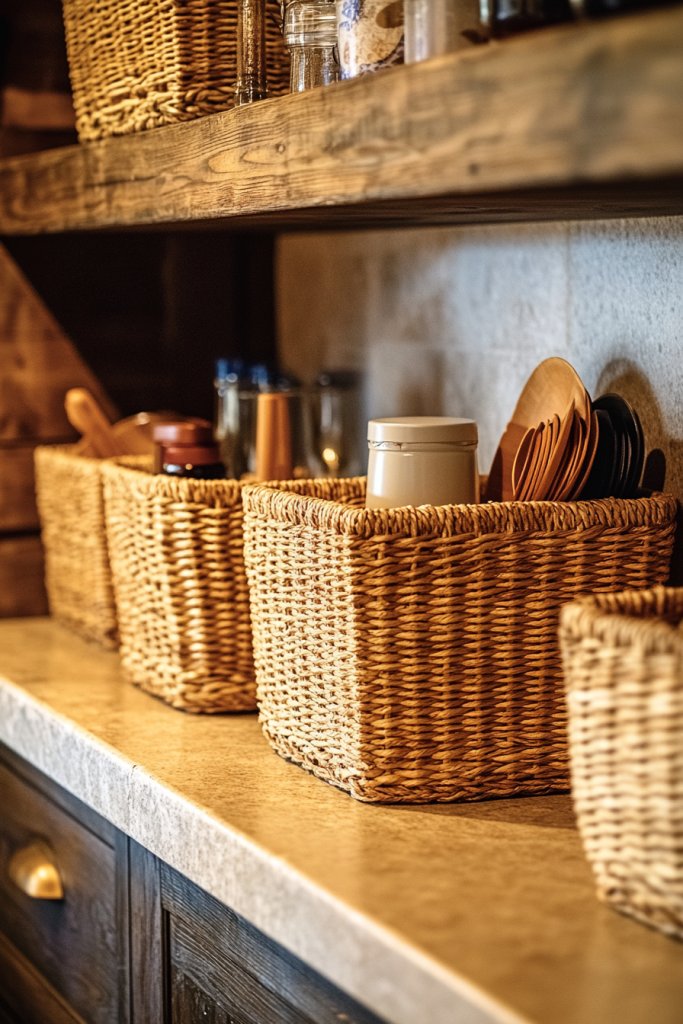
Ever feel overwhelmed with clutter but hate the look of plastic containers? Storing essentials in open baskets made from natural materials offers a stylish solution that keeps your space tidy and organic. Wicker or seagrass baskets add warmth and texture, elevating your storage game.
Imagine woven baskets in light beige or caramel tones lining open shelves or under the counter. They hold fresh produce, utensils, or fresh linens, adding a tactile element to your kitchen. The natural fibers’ rough texture contrasts beautifully with smooth ceramics and sleek wood, creating a layered, inviting look. Sunlight highlights the weave’s intricate patterns, adding visual depth.
Choose baskets in different sizes for varied items—small for herbs or spices, larger for vegetables or cookware. For a more polished look, opt for baskets with leather or fabric accents. Seasonal swaps can include colorful or patterned woven baskets for a playful touch. Use stackable or nesting designs to maximize space and flexibility.
Select baskets made from sustainably harvested wicker or seagrass with tight weaves for durability. Use open shelving, cabinets, or under-sink areas to place them. Label baskets for easy identification of contents. Keep them clean with gentle brushing or a damp cloth. Position larger baskets at the bottom for stability and smaller ones at eye level.
Add decorative touches like leather straps, fabric linings, or hand-painted designs to personalize your baskets. Incorporate natural fiber ties or tags for organization. Mix textures by combining wicker with rattan or bamboo. Use baskets to create a cozy, organized look that’s both functional and beautiful.
Open storage baskets in natural fibers bring a relaxed, organic feel to your kitchen. They make organization effortless and stylish at the same time. By choosing eco-friendly materials, you support sustainability while creating a warm, inviting space. It’s a simple upgrade that truly makes a difference.
10. Integrate Large, Potted Indoor Herbs for Freshness and Decor
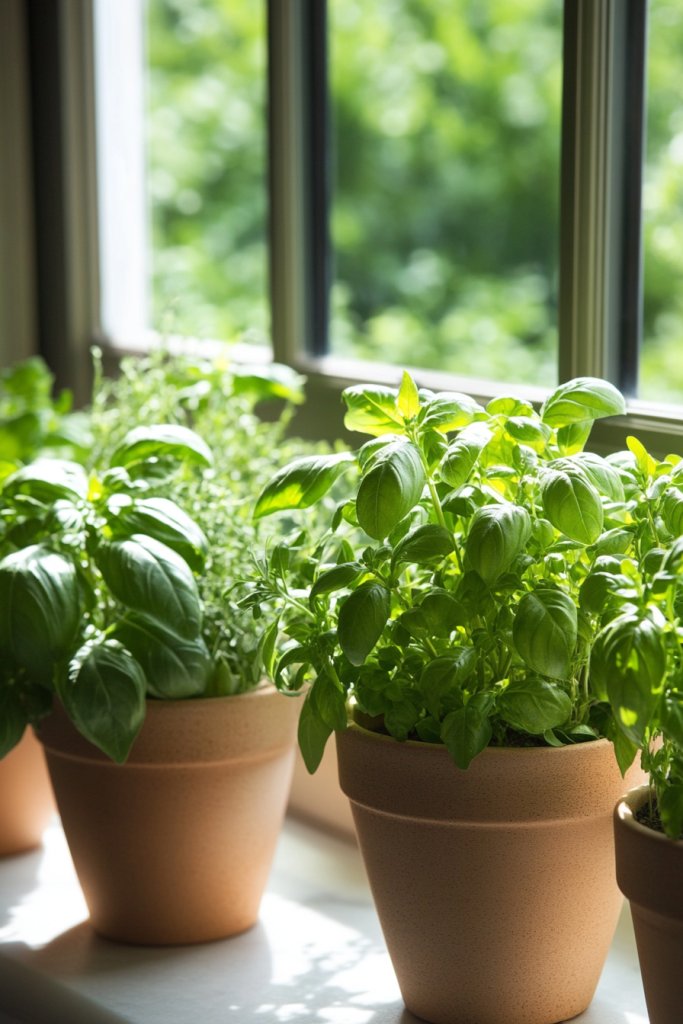
Craving fresh herbs but tired of buying plastic-wrapped bunches? Growing your own herbs not only supplies fresh flavor but also adds lush greenery to your kitchen decor. Potted herbs bring life and aroma without cluttering your workspace, making cooking more enjoyable.
Imagine a row of simple terracotta pots with basil, thyme, and rosemary lined along a sunny windowsill. The vibrant green leaves contrast beautifully with neutral countertops and textured backsplashes. The herbs sway gently with the breeze, filling your space with fresh, herbal scents. It’s a living, breathing element that elevates your kitchen’s natural vibe.
Use uniform pots for a streamlined look or mix textures—clay, ceramic, or recycled materials—for a more eclectic feel. In compact spaces, hanging planters or wall-mounted containers save surface space. Change plant arrangements seasonally with different herbs or edible flowers. Incorporate eco-friendly watering systems or self-watering pots for low-maintenance care.
Choose healthy, organic herbs from reputable nurseries or grow your own from seeds. Use well-draining soil and position pots in natural light for optimal growth. Water regularly but avoid overwatering—most herbs prefer slightly dry soil. Keep the pots elevated on natural fiber mats or wooden trays to prevent water damage. Regular pruning encourages healthy growth.
Decorate pots with painted designs or natural fiber wraps. Label herbs with handcrafted tags or engraved stones for easy identification. Pair with simple wooden or ceramic tools to complete the look. Rotate herbs seasonally for variety and fresh flavors. Use them as centerpieces or accents wherever you cook.
Growing herbs in your kitchen connects you to nature and enhances your culinary experience. It’s a simple, sustainable way to add greenery and freshness. Plus, your space will smell amazing without any artificial fragrances. With a little care, you’ll enjoy a lush, organic, and functional kitchen garden.
11. Install Reclaimed Wood or Cork Flooring for Warmth Underfoot
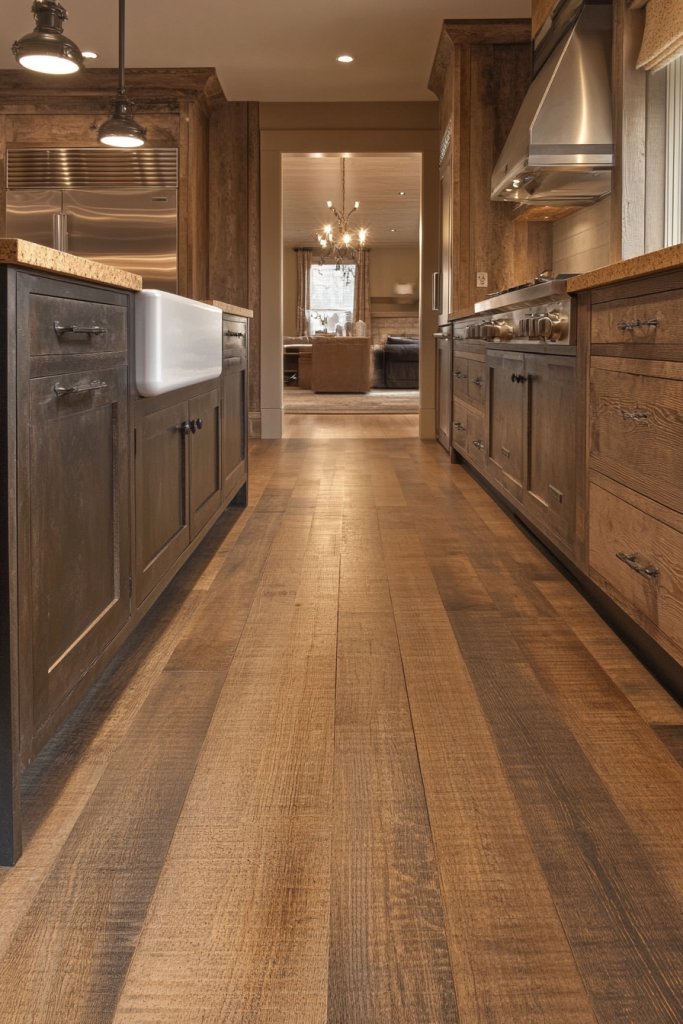
Tired of cold, hard floors that clash with your organic aesthetic? Standard tile or laminate can feel disconnected from nature. The solution? Reclaimed wood or cork flooring that offers warmth, texture, and eco-friendliness. It transforms your kitchen into a cozy, inviting space.
Picture warm-toned cork tiles or weathered reclaimed wood planks underfoot. The natural grain and slight imperfections add character, creating a rustic yet refined look. Soft light reflects off the textured surface, enhancing the organic vibe. It pairs beautifully with natural textiles and handcrafted accessories, making every step feel grounded.
Choose cork for a softer, quieter surface in open-plan kitchens, or opt for reclaimed wood for a more rugged, vintage feel. Light-colored woods brighten small spaces, while darker finishes add depth in larger rooms. Seasonal rugs in natural fibers or woven textures can add warmth and comfort. Both options are versatile enough to fit various decor styles.
Source sustainably harvested cork tiles or reclaimed wood planks from reputable suppliers. Hire professionals for precise installation, ensuring proper sealing and leveling. Maintain cork floors with gentle cleaners and avoid excessive moisture. Reclaimed wood may require sanding and sealing to prevent splinters and damage. Regular care preserves the natural texture and appearance.
Add decorative inlays or border trims in contrasting woods or cork patterns. Use natural fiber rugs or woven mats to enhance comfort. Incorporate handcrafted or vintage furniture to complement the flooring. Keep the surface clean and protected with eco-friendly sealants that maintain the organic look.
Eco-friendly flooring options like cork or reclaimed wood make your kitchen feel warm, natural, and sustainable. They support a healthy home environment and age beautifully with minimal upkeep. Your space will radiate authenticity and charm, making every step a pleasure. Embrace these natural materials for a truly organic foundation.
12. Opt for Clear Glass or Ceramic Canisters for Food Storage
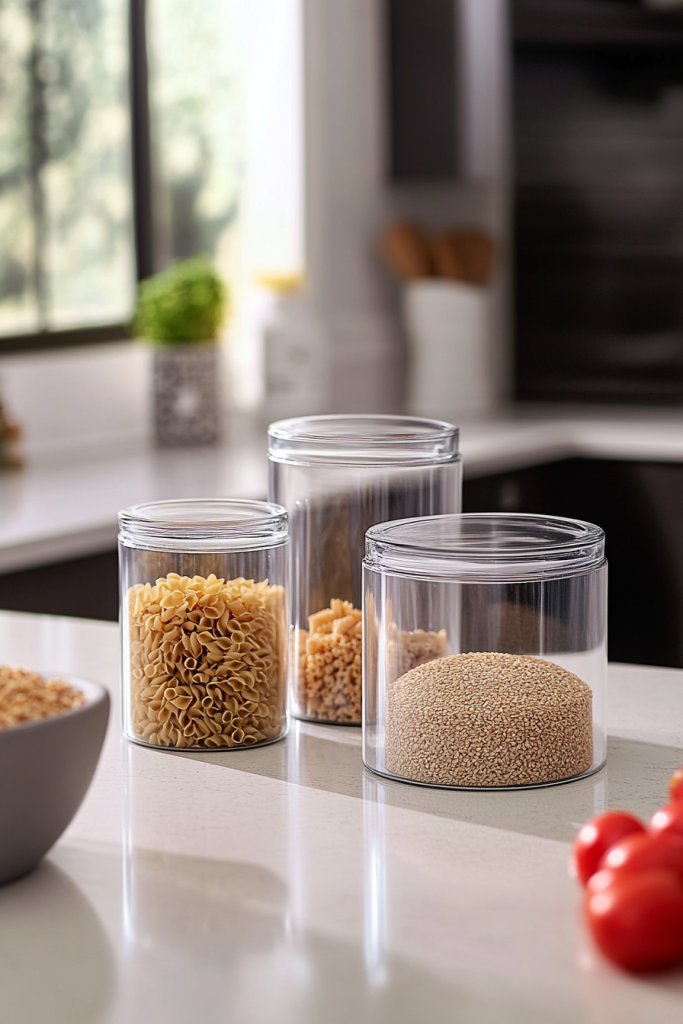
Does your cluttered countertop make your kitchen look chaotic? Clear storage containers in plastic or metal often disrupt the natural aesthetic. For a cleaner, more organic look, opt for glass or ceramic canisters that showcase your pantry staples beautifully.
Imagine uniform glass jars with wooden or matte-finish lids, filled with grains, beans, or dried herbs. Their transparency allows a quick glance, reducing the need for rummaging. The simple, clean lines complement natural wood and textured textiles, creating a harmonious, organized space. The contents become part of the decor, adding visual interest.
Choose minimalist cylindrical or square shapes in frosted or clear glass, or opt for handmade ceramic containers with subtle textures. Label jars with natural fiber or recycled paper tags for a personalized touch. For seasonal updates, replace contents with dried flowers or colorful spices stored in decorative containers. Keep the arrangement neat and accessible.
Select lead-free, food-safe glass or ceramic containers with airtight seals. Arrange them on open shelves or in a dedicated pantry area. Use uniform sizes for a tidy look, or mix shapes for visual interest. Label them with natural ink or embossed stamps for easy identification. Regularly clean and refill to maintain freshness and organization.
Create a cohesive look with matching lids or textured ceramics. Incorporate handcrafted labels or painted designs for a personal touch. Use natural fiber baskets or trays to group related items. Keep your pantry inviting by displaying seasonal herbs or dried flowers in small vases or decorative bowls.
Clear food storage in glass or ceramic elevates your kitchen’s look while supporting sustainable practices. It simplifies meal prep and adds a layer of visual calm. With everything neatly stored and visible, cooking becomes more enjoyable. Embrace simple, elegant solutions for a beautifully organized space.
13. Incorporate Minimalist, Functional Open Shelves for Daily Use Items
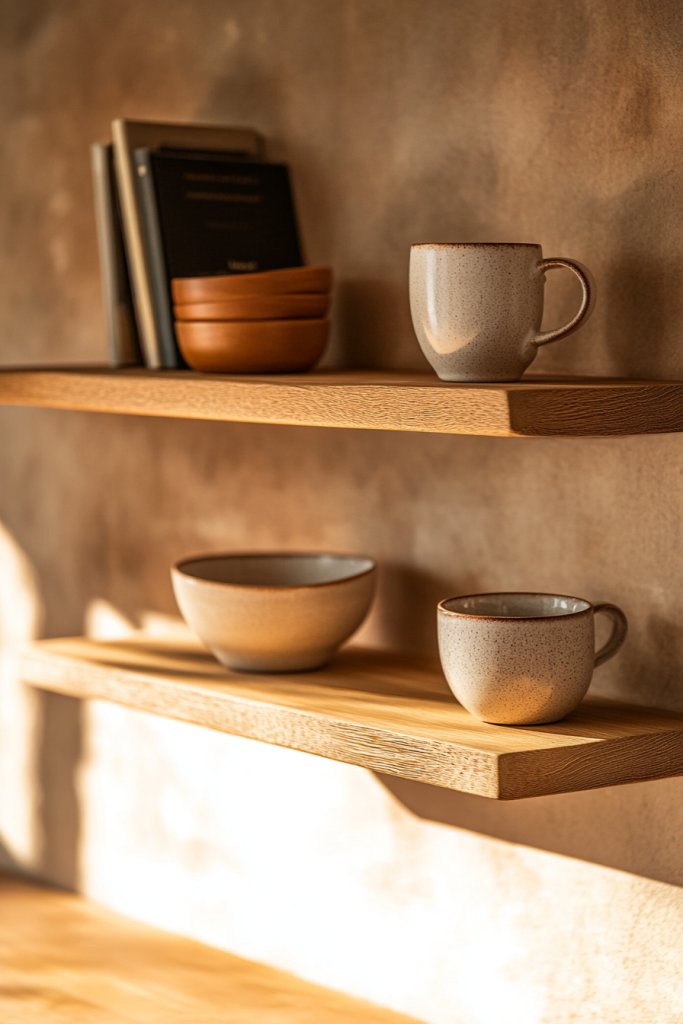
Feeling overwhelmed by cluttered cabinets? Sometimes, the best way to keep your kitchen functional and stylish is to display your essentials openly. Minimalist open shelves make everyday items accessible while maintaining a clean, organic look. It’s all about practicality meets simplicity.
Visualize sleek wooden or metal open shelves mounted on a neutral wall, holding neatly arranged utensils, bowls, and jars. The open display showcases natural textures and finishes, creating visual rhythm. Items are arranged in a way that balances form and function, with plenty of negative space for breathing room. Sunlight highlights the simplicity and clarity of the arrangement.
Use floating wood or metal shelves with minimal hardware for a seamless look. For a more rustic feel, incorporate reclaimed wood with visible grain and imperfections. In small spaces, narrow shelves keep everything within reach, while larger kitchens can feature multiple tiers for more storage. Rotate items seasonally to keep the display fresh.
Choose sturdy, eco-friendly shelving materials that match your decor. Securely mount shelves at ergonomic heights, considering accessibility. Organize items by frequency of use—daily essentials at eye level, less-used items above or below. Use natural fiber or wooden containers to keep small items tidy. Regularly dust and declutter for a clean, functional look.
Add handcrafted or engraved tags to containers or utensils for a personal touch. Incorporate decorative elements like woven baskets or textured cloths underneath shelves. Mix and match different wood tones or finishes to add visual interest. Keep the setup simple but personalized to reflect your style.
Open, minimalist shelves make your kitchen more accessible and organized. They reveal your everyday essentials beautifully and encourage a clutter-free lifestyle. With thoughtful arrangement, they create an inviting, functional space that’s easy to love. Embrace simplicity for a more natural, streamlined kitchen.
14. Use Neutral, Textured Fabric Curtains or Roller Blinds

Are shiny, plastic blinds ruining your organic aesthetic? Harsh window treatments can clash with natural textures and materials. Soft, textured fabric curtains or roller blinds in neutral tones create a warm, inviting atmosphere while providing privacy. It’s a small change with a big impact.
Imagine linen or hemp curtains in soft beige draping gently over large windows. The textured fabric adds depth and softness, catching diffused natural light. When drawn, they create a subtle, tactile backdrop that complements wood cabinetry and woven accents. The fabric’s natural fibers evoke comfort, blending seamlessly with organic decor.
Opt for simple roller blinds in linen or hemp for a sleek, modern look. For a more relaxed vibe, choose flowing, hand-stitched curtains with raw edges. Use layered window treatments—sheer curtains combined with heavier drapes—for seasonal flexibility. Match the fabric color to your wall or cabinetry for a cohesive feel.
Select natural fiber fabrics that allow light to filter softly while maintaining privacy. Install sturdy curtain rods or discreet roller mechanisms, ensuring smooth operation. Use eco-friendly, low-impact dyes to preserve the organic look. Regularly wash and maintain the fabric to keep it fresh and inviting. Consider blackout options for bedrooms or workspaces.
Add handcrafted tiebacks or fabric trims in contrasting textures for a personalized touch. Use decorative loops or wooden rings to hang curtains in style. Incorporate subtle embroidery or natural dyes to enhance the organic feel. Pair with matching cushion covers or tablecloths for a unified aesthetic.
Textured fabric curtains soften your space and add warmth naturally. They’re versatile and easy to update with changing seasons or moods. Embrace natural fibers to create a cozy, organic environment that feels handmade and heartfelt. It’s a simple detail with a lasting impact.
15. Add Stone or Concrete Sinks for a Modern, Natural Touch
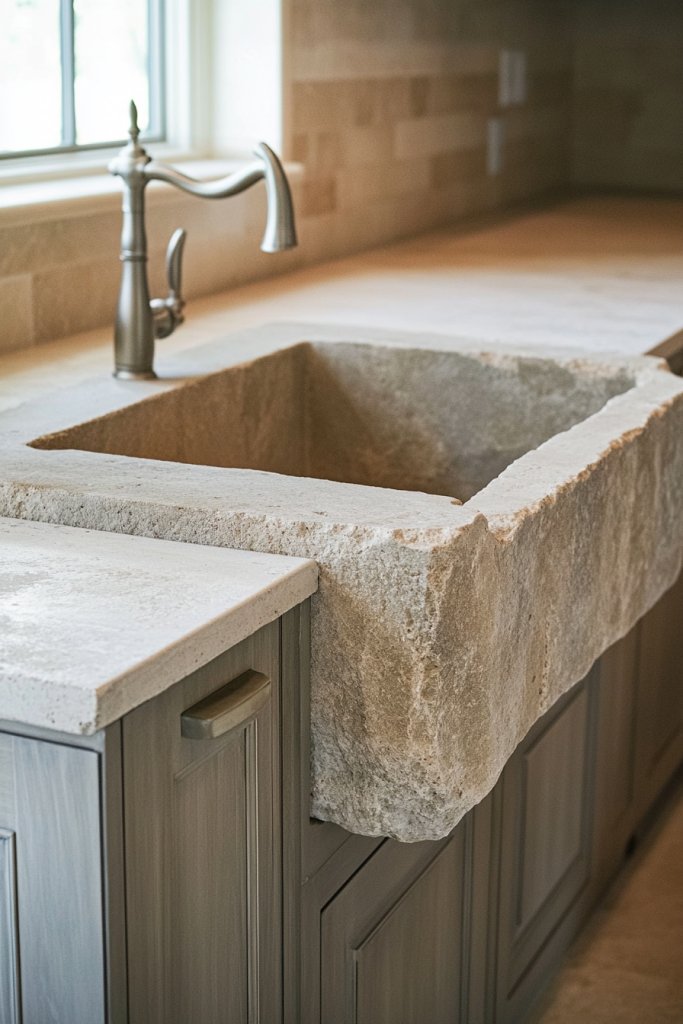
Looking for a sink that combines durability with organic style? Many modern sinks feel cold or overly sleek, clashing with natural decor. Stone or concrete sinks bring a raw, earthy element that balances modern functionality with natural beauty. It’s a statement that’s both practical and aesthetic.
Imagine a smooth concrete undermount sink in a neutral gray, set into a reclaimed wood countertop. The textured surface contrasts gently with softer materials like linen or wood accents. The natural variations in the concrete add character, making each sink one-of-a-kind. The minimalist design emphasizes clean lines and durable craftsmanship.
Choose from polished or matte finishes in natural stone like limestone or travertine for a softer look. For an industrial feel, opt for exposed concrete with visible aggregate. Pair with brass or matte black fixtures for a modern touch. Incorporate natural fiber towels and handcrafted soap dishes to complete the organic aesthetic. Seasonal updates include textured mats or wooden accessories.
Work with professionals experienced in concrete or stone installation to ensure proper sealing and support. Select pre-cast sinks or custom-molded pieces for best fit. Seal the surface with eco-friendly, food-safe sealants that prevent staining and water damage. Regular cleaning with gentle, pH-neutral cleaners preserves the natural look. Consider integrated drainboards or custom accessories for added utility.
Personalize with engraved patterns or subtle color accents within the concrete or stone. Use handcrafted ceramic or wood accessories to enhance the organic vibe. Incorporate textured or patterned mats and soap dishes to complement the sink’s rugged beauty. Keep the area clutter-free for a streamlined, natural aesthetic.
Stone or concrete sinks anchor your kitchen’s natural style, offering longevity and ease of maintenance. They support a minimalist, yet earthy look that’s timeless. With proper care, they age beautifully, developing a unique patina. Embrace these natural materials for a durable, stylish upgrade.
16. Create a Green Wall with Non-Invasive, Low-Maintenance Plants
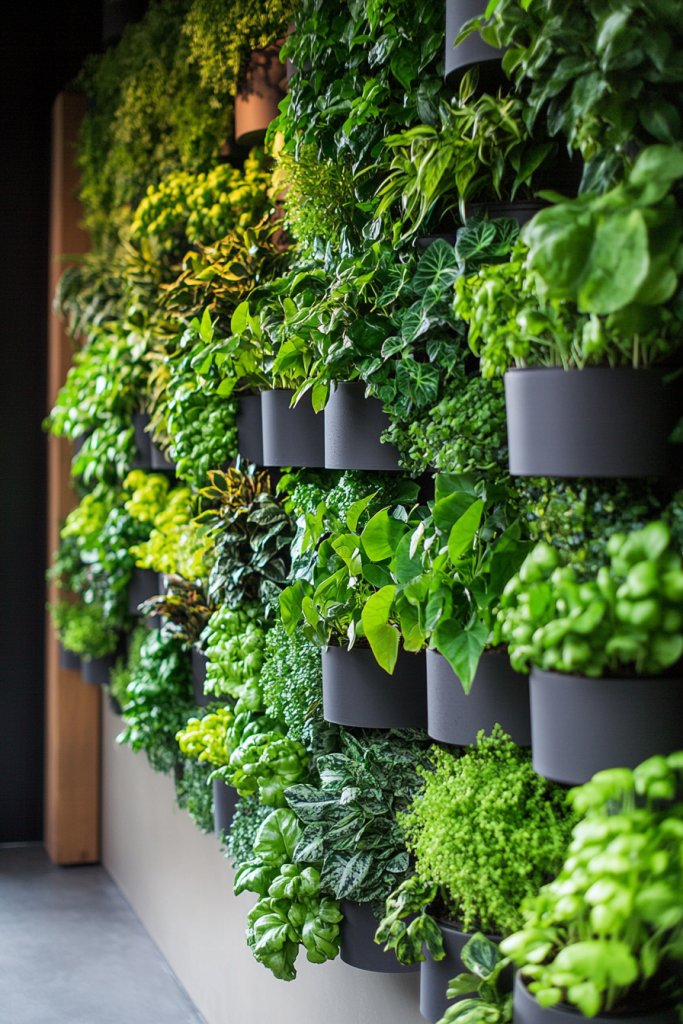
Want to add lush greenery without the hassle of high-maintenance plants? A green wall with hardy, low-maintenance plants can bring life and vibrancy to your kitchen. It’s a natural focal point that requires minimal effort, perfect for busy lifestyles.
Picture a vertical garden of succulents or air plants mounted on a textured wall, with natural wood or stone framing. The greenery’s subtle variations in shape and color create a dynamic yet calming visual. The plants breathe life into the space, filling it with fresh energy and natural beauty. Light filters through, highlighting the lush foliage.
Choose non-invasive plants like succulents, air plants, or moss for easy care. Use modular wall planters or mounted pots made from recycled materials. For seasonal interest, incorporate dried flowers or preserved moss that require no watering. Adjust the layout to suit your space, from a small corner to an entire wall.
Install a simple modular system or wall-mounted planter with a drip tray. Use soil-less or nutrient-enhanced growing mediums for low maintenance. Position the wall where it receives indirect light for optimal growth. Water sparingly and regularly check for pests or mold. Use natural, eco-friendly fertilizers if needed.
Frame the green wall with reclaimed wood or textured tiles to enhance its organic appeal. Add handcrafted or recycled decorative elements nearby. Incorporate small sculptures or textured stones for visual interest. Keep the overall design minimalist to let the plants shine.
A low-maintenance green wall transforms your kitchen into a lively, natural sanctuary. It supports eco-friendly living and adds visual tranquility. You’ll enjoy the benefits of nature without the upkeep of traditional gardens. It’s an inspiring feature that elevates your entire space.
17. Incorporate Simple, Handmade Pottery for Utensils and Serveware
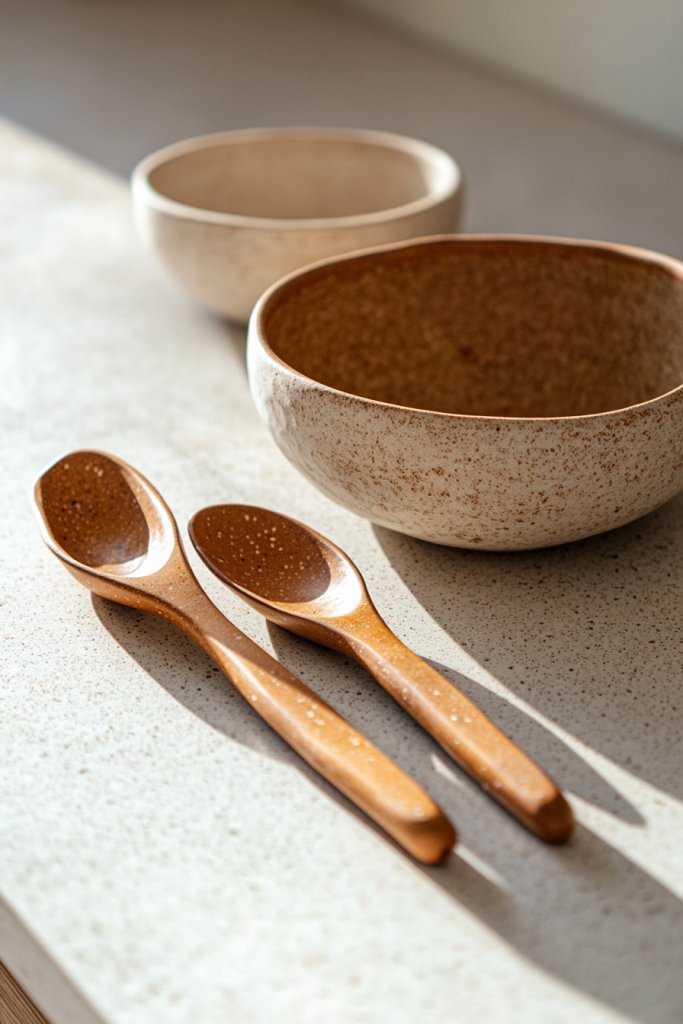
Bored of mass-produced, cookie-cutter serveware? Handmade pottery offers a unique, organic touch that elevates your kitchen aesthetic. It’s a way to showcase craftsmanship and add personality while supporting small artisans. Plus, it feels more authentic than factory-made pieces.
Imagine a set of hand-thrown bowls and mugs with subtle irregularities, glazed in earthy tones like soft greens, browns, and creams. These pieces sit on open shelves or countertop displays, adding texture and warmth. Their tactile surfaces invite touch, while their imperfect shapes evoke a sense of natural beauty. Combined with textured linens and wood accents, they create a cozy, artisanal vibe.
Mix different shapes and sizes for a curated, eclectic look, or stick to a matching set for simplicity. Use textured or matte glazes to enhance organic appeal. Incorporate handcrafted utensils like wooden spoons or ceramic ladles for a cohesive, artisanal feel. Rotate serveware seasonally to keep the aesthetic fresh and engaging.
Source pottery from local artisans or craft fairs, or try your hand at pottery-making classes. Handle and care for handmade ceramics by avoiding sudden temperature changes and using gentle cleaners. Display the pieces prominently on open shelves or in glass-front cabinets. Use them daily for a functional yet decorative touch. Regularly inspect for cracks or chips and handle with care.
Order custom pieces with engraved initials or personalized glazes. Incorporate natural fiber or linen cloths that complement the earthy tones. Use handcrafted pottery as giftware or heirlooms. Mix glazes and textures to reflect your personal style and keep the collection lively.
Handmade pottery celebrates craftsmanship and adds an organic, artisanal touch to your kitchen. It makes everyday meals feel special and supports small-scale artisans. With a little care, these pieces become cherished parts of your home, blending beauty and function seamlessly.
18. Use Neutral, Matte-Finish Kitchen Appliances and Accessories
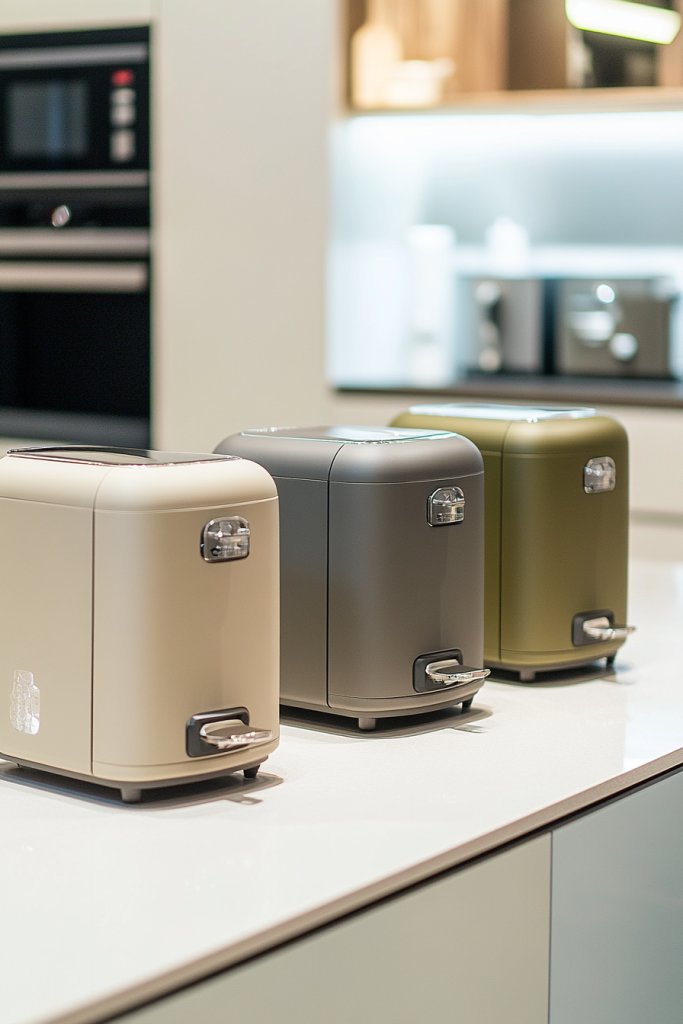
Overly shiny appliances can clash with a natural, organic kitchen style. Bright stainless steel or gloss finishes tend to feel cold and modern, detracting from a warm, earthy vibe. Matte, neutral-toned appliances and accessories provide a subtle, cohesive look that blends seamlessly with organic decor.
Picture matte black or muted earth-toned appliances on a background of textured wood and soft linen textiles. The matte finish absorbs light, reducing glare and creating a calming environment. The subdued palette emphasizes natural textures and materials, giving your kitchen a sophisticated yet understated feel. The accessories—utensil holders, spice racks, and small gadgets—match in tone, completing a cohesive aesthetic.
Choose appliances in shades like warm taupe, soft gray, or brushed bronze for versatility. For a more rustic look, opt for matte copper or bronze finishes. In small kitchens, compact or integrated appliances keep the space uncluttered. Seasonal accents like soft-colored towels or natural fiber mats can add a pop of subtle color.
Select high-quality, energy-efficient appliances with matte finishes from reputable brands committed to sustainability. Keep accessories in matching tones to create harmony. Use natural fiber or linen covers for extra protection and aesthetic appeal. Regularly clean with gentle, non-abrasive cleaners to preserve the matte surface. Consider modular or built-in options to maximize space.
Add handcrafted or engraved handles in matching tones for a bespoke touch. Incorporate natural fiber or linen storage containers to complement the matte finish. Use decorative textiles or woven baskets nearby to soften the look. Keep the overall scheme minimal to let the appliances blend into the organic aesthetic.
Neutral, matte-finish appliances support a calm, cohesive kitchen design rooted in natural materials. They’re timeless, easy to maintain, and versatile across styles. When chosen thoughtfully, they help create a space that feels warm, elegant, and effortlessly stylish. Embrace these finishes for a modern-organic vibe you’ll love.
19. Integrate Functional Wooden or Bamboo Cutting Boards as Decor
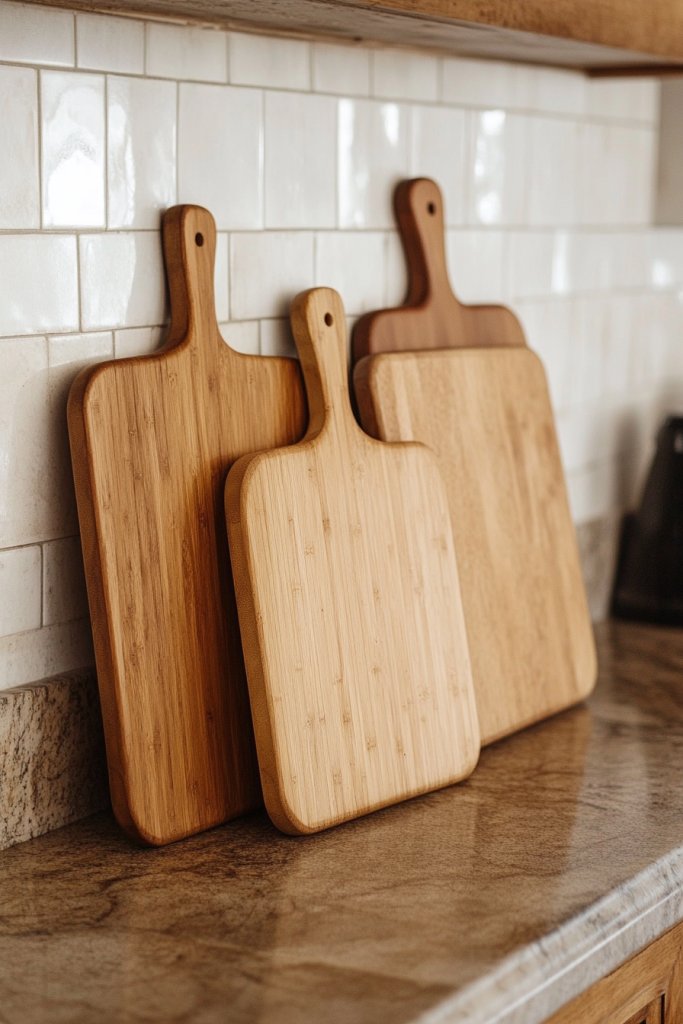
Tired of cluttered countertops with dull, unused cutting boards? Why hide your beautiful wooden or bamboo boards when they can be part of your decor? When displayed thoughtfully, they add warmth, texture, and function to your kitchen. It’s a win-win for style and practicality.
Imagine large, handcrafted wooden cutting boards leaning against a backsplash, their natural grain bringing a rustic charm. Some are engraved or have live edges, emphasizing organic beauty. They serve as both prep surfaces and decorative accents, especially when paired with simple ceramic jars and linen towels. The warm tones and varied textures create a cozy, inviting atmosphere.
Display boards vertically for a striking visual statement or lay them flat with decorative food items or herbs. Use different wood tones—light maple, rich walnut, or bamboo—to add variety. For seasonal decor, incorporate small potted herbs or dried flowers on or around the boards. Rotate pieces to showcase different grains and finishes.
Choose high-quality, sustainably sourced wood or bamboo that resists knife marks and moisture. Store or display boards on open shelves, hooks, or in decorative racks. Treat wood with food-safe oils regularly to maintain their appearance and durability. Use them actively for prep work or as serving platters for cheese and charcuterie. Keep them clean and dry after use.
Engrave names, dates, or simple designs for a personal touch. Pair with handcrafted pottery or ceramic bowls to complete the organic aesthetic. Use fabric wraps or leather straps for hanging or presentation. Incorporate seasonal motifs or painted patterns for a fresh look throughout the year.
Functional wooden and bamboo boards blend beauty and utility seamlessly. They add warmth and texture, elevating your kitchen decor while supporting everyday tasks. With proper care, they age gracefully and become treasured pieces in your home. Celebrate natural materials for a timeless, welcoming kitchen.
20. Opt for Minimalist, Organic-Inspired Kitchen Tools and Gadgets
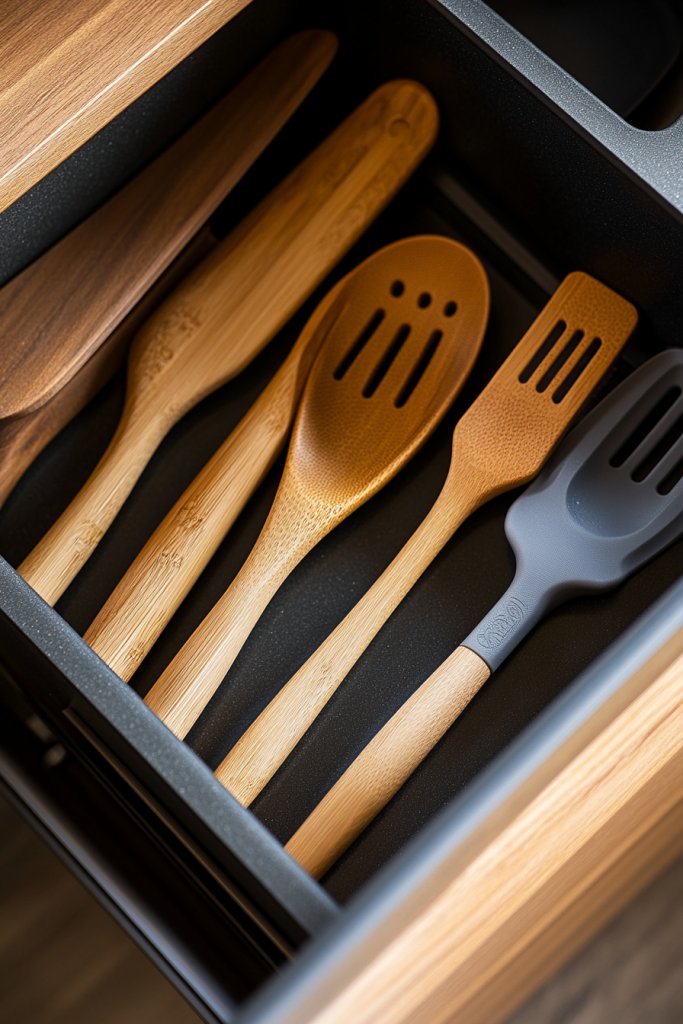
Are your kitchen gadgets cluttering your space and clashing with your organic decor? Modern, minimalist tools made from natural materials can streamline your workspace and enhance your aesthetic. They’re functional, beautiful, and perfect for a natural, clutter-free kitchen.
Imagine wooden spoons, silicone spatulas with matte finishes, and bamboo tongs neatly arranged in a handcrafted ceramic holder. The neutral tones and simple shapes blend effortlessly with textured linens and natural wood surfaces. Every tool feels like part of a curated collection, adding understated elegance and convenience.
Choose tools in shades like beige, taupe, or soft gray—materials like bamboo, silicone, or recycled wood fit well. Keep them in open containers or hang on minimalist hooks for easy access. Seasonal updates include adding colorful silicone or textured grips, or mixing in artisanal utensils. Ensure everything maintains a natural, understated look.
Source tools from brands committed to sustainability, favoring recycled or biodegradable materials. Organize them in handcrafted ceramic or wooden holders that match your organic aesthetic. Clean with gentle soap and avoid harsh abrasives to preserve finishes. Use hooks or magnetic strips to keep counters clear. Regularly inspect for wear and replace when needed.
Add engraved initials or patterns to wooden handles for a personal touch. Mix different textures—smooth silicone, rougher wood—for visual interest. Incorporate handcrafted or recycled accessories to complement the tools. Keep the tools organized and accessible for everyday use.
Minimalist, organic-inspired tools make your kitchen more functional and beautiful. They support a natural aesthetic while simplifying cooking tasks. With thoughtful selection, your space will feel cohesive, modern, and inviting. Embrace simplicity and quality for a truly organic vibe.
21. Keep Countertops Clear and Maintain a Clutter-Free, Functional Space
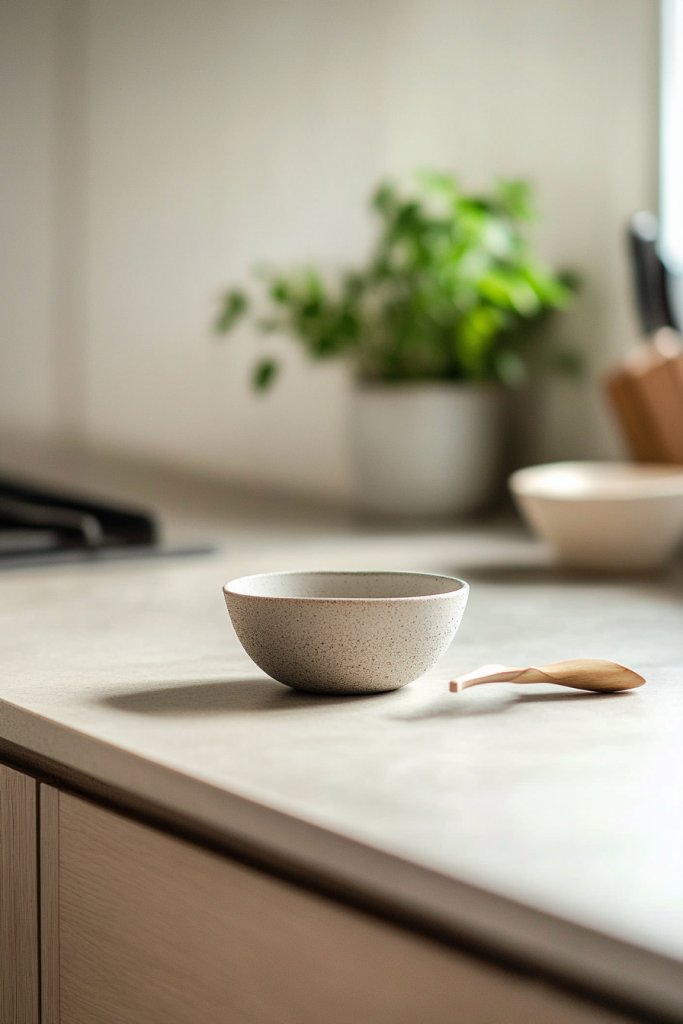
Cluttered countertops can turn your kitchen into a chaotic mess rather than a peaceful, organic retreat. The secret is maintaining a clear, organized space that supports both function and aesthetics. A clutter-free countertop makes cooking easier and elevates the natural vibe of your kitchen.
Imagine a pristine surface with only a few carefully chosen items—like a handcrafted wooden utensil holder, a simple ceramic bowl, and a textured linen cloth. Everything is within reach but not overwhelming. The clean surface reflects light softly, emphasizing natural textures and materials. It invites you to cook, prep, and gather effortlessly.
Use hidden storage solutions, like drawers or cabinet organizers, to keep things out of sight. Incorporate multipurpose items that serve both decorative and functional roles. Regularly declutter by removing unused gadgets or utensils. Seasonal swaps with natural textiles or simple accessories keep the space feeling fresh and intentional.
Invest in quality storage containers, drawer dividers, and organization tools to maximize space. Designate specific zones for prep, cleaning, and storage to streamline workflows. Use minimalist trays or baskets to corral small items. Schedule regular tidying sessions to maintain the calm, natural aesthetic. Keep only essential tools on the surface.
Customize with handcrafted labels, natural fiber mats, or simple decorative accents that reflect your style. Incorporate subtle color accents through textiles or utensils to add visual interest without cluttering. Use sleek, integrated appliances to free up counter space. Keep everything accessible and visually harmonious.
A clutter-free kitchen radiates calm and organic beauty, making daily routines more enjoyable. It helps you focus on what truly matters—cooking, creating, and gathering. With organization and intentional design, your space becomes a sanctuary that supports a natural, relaxing lifestyle. Less truly is more.
Conclusion
This collection of simple organic modern kitchen ideas showcases how natural elements and clean design can transform your space into a functional, inviting sanctuary. By incorporating these concepts, you can craft a kitchen that is both stylish and practical, perfectly suited to your lifestyle. Embrace these ideas and take the first step toward creating a kitchen that reflects your love for nature and modern living—your ideal space is within reach.
